Inside the start-ups, innovators and entrepreneurs changing Adelaide
How can SA throw off the shackles of federal handouts and GST dividends and become an “absolute powerhouse economy”? Because we already have everything we need.
SA Weekend
Don't miss out on the headlines from SA Weekend. Followed categories will be added to My News.
South Australia is just three good decisions away from being an economic powerhouse, as long as we can properly harness our natural resources and take control of our destiny, says the state’s Chief Entrepreneur Andrew Nunn.
One key was to give extractive companies a “use it or lose it” ultimatum for the management of natural resources.
In an in-depth interview with SA Weekend to discuss the continued growth of Lot Fourteen and the state’s ongoing innovation agenda, Mr Nunn said there was still much work to be done and leadership to be shown to ensure South Australia could operate independently from the vagaries of federal handouts and GST dividends.
“We are literally three really good decisions away from being an absolute powerhouse economy,” Mr Nunn said.
“And it should be, it’s got everything. We will be literally the home of hydrogen; we’ve got more solar, more wind, and we don’t have cyclones.”
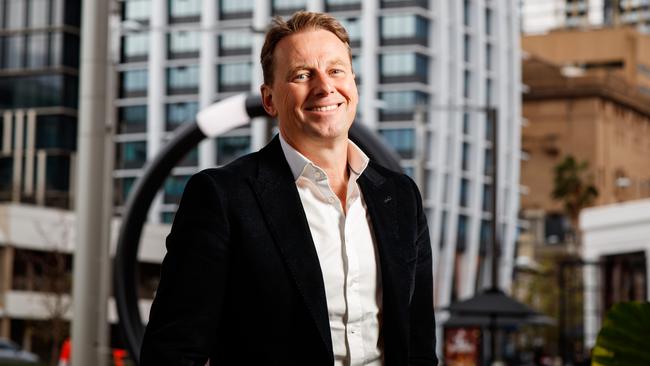
He said the state should also play to its strengths, particularly its strong copper reserves.
“We have more than 70 per cent of Australia’s copper in the far north of SA,” he said. “Copper is the metal of the future. You can make as many electrons as you want. You can’t move solar without copper. It’s a very small leap for us, with our rare earths and our copper, to start building our batteries; all those things we can start doing in South Australia, but we have to get on with it.
“It’s probably a bit of a socialist view, but for all of our natural resource, in my view these are the resources that will build the state and they need to be designed and managed by the state.
“And I don’t think anyone realises how geographically brilliantly we are placed for all these energies.
“So, yes the state has given you a licence to do it, I think either use it or lose it and give someone else a go.”
His words appeared to echo those of Prime Minister Anthony Albanese who told a Minerals Council of Australia dinner earlier this month the sector would be the “foundation” for jobs and growth in a decarbonising world through escalating production of copper, lithium, rare earths and nickel.
Mr Nunn said his hope was that, by 2030, South Australia was standing on its own two feet. “I’d love to see we’re mining more copper than anyone else, we’re doing it sustainably and we’re doing it with renewable water resources,” he said.
“I want us to be the biggest exporter of hydrogen in the world. I want us to be the richest state in the Commonwealth. And that’s our vision. Our resources are so diverse and the world needs our resources. There really is no excuse.”
Inside the start-ups, innovators and entrepreneurs changing Adelaide
Daish Malani is walking around with a pair of virtual reality goggles.
No one bats an eyelid. He moves his arms up and down grasping and pushing at invisible objects.
Nearby, groups of people are mulling around a table filled with cakes and fruit.
The crowd is starting to build. There’s now more than 50 people in the room.
They’re all members of SA teams working out of start-up hub Stone & Chalk, who meet every day to share ideas, wins, losses and everything in between.
All looking for a break. Looking to make a difference. Looking to make their mark on the world.
Their company titles sit side-by-side on circular plates on the wall.
Name it and they’re probably doing it. Climate and environment projects, artificial intelligence (AI), cyber security, defence and space are the more common themes.
Chris Kirk takes the microphone.
A towering figure with a shaved head and beard, he asks any newbies to introduce themselves.
A young, fresh-faced bloke gets up. “I’m Ed*,” he says and reveals he’s working on a start-up that involves education and space.
“It’s actually my first day,” he says.
The group applauds.
Another talks about cybersecurity.
A third then reminds the group the Corporate Cup run is starting up again and for people to get their teams in.
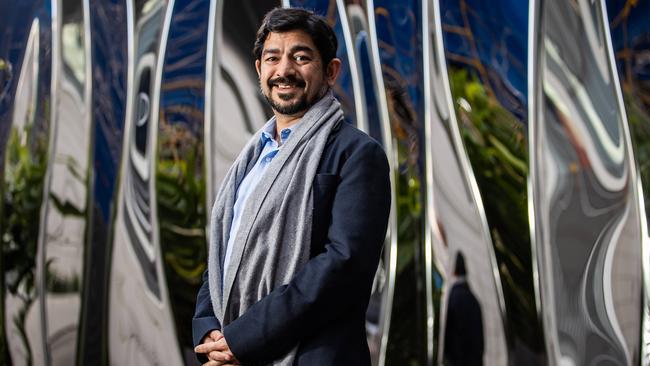
Kirk grabs the mic again: “So who wants to share some wins?” After a little hesitance, Marco gets up and talks about his company Hubble just signing a deal with two bidders in Australia and New Zealand. His company uses AI to analyse building designs for energy efficiency.
More applause.
Kirk finishes off by inviting the group to a session on sales and social media which features two South Australians who set up their business in a home garage.
“Actually, I didn’t know about them at all,” he says. “They were one of the first Australian companies to set up a YouTube channel that ranked in the top 100 watched channels globally. They unbox toys for kids on YouTube.”
There are audible gasps (the company is FluffyJetProductions).
The meeting finishes and the group disperses.
Two people exchange details by scanning a barcode.
It may not necessarily occur to any of them at this moment but what they are doing here is pretty significant.
Some would argue a fair chunk of the future economic prosperity of this state rides on their success or failure.
Regardless, the energy is high and the sense of team palpable.
Welcome to Lot Fourteen.
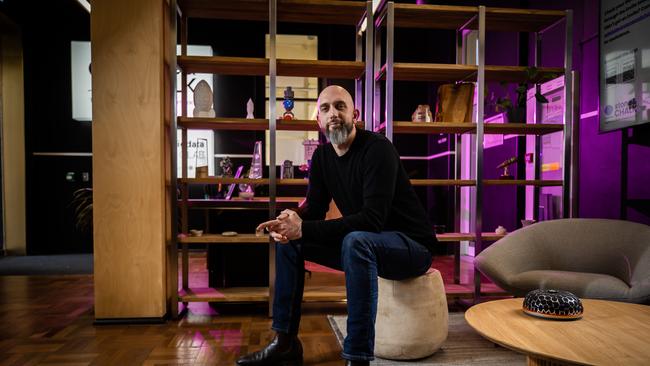
THE HEART OF INNOVATION
There’s a scene in Oliver Stone’s 1991 JFK when Kevin Costner, playing district attorney Jim Garrison, is leading his small legal team through New Orleans. He stands on a corner and points to the Office of Naval Intelligence, then across the road at the FBI, then the CIA, then the secret service.
“We are standing in the heart of the United State’s government’s intelligence community …” he says.
It’s a scene which springs to mind standing out the front of Lot Fourteen, the 7ha site which was once the home of the old Royal Adelaide Hospital.
Straight ahead is the busy Community cafe, a glance to the right reveals the grey frontage of the Australian Space Discovery Centre.
Slightly to the left sits the Startup Hub, housing Stone & Chalk, The MIT bigdata Living Lab, and the Office of the Chief Entrepreneur, Andrew Nunn.
A little further left and you walk straight into the red bricks and cream frontage of the Australian Institute for Machine learning (the opening to the old RAH) and behind that the historic Eleanor Harrald Building, which is home to the Australian Cyber Collaboration Centre (A3C) and The Circle – First Nations Entrepreneur Hub.
A quick stroll towards the Botanic Gardens (you’ll walk past the Bice Building which houses, among other things, the Bureau of Meteorology) and hard-hatted workers stand out the front of a gated construction site that is set to house Tarrkarri, the long awaited $200m Centre for First Nations Cultures.
Back-pedal to the space discovery centre and continue past modern steel frontages to find the Australian Space Agency.
Beyond that there’s another worksite where the eventual centrepiece of the precinct will stand, the multistorey Entrepreneur and Innovation Centre and Innovation Hub which, according to the glossy brochures, will look like something out of Westworld.
Across the traffic lights towards the city sits the universities of Adelaide and SA, and Defence SA. Catch a tram and you’ll be at SAHMRI or the RAH in five minutes. A few corners down is the University of Adelaide’s ThincLab, its flagship business incubator.
To misquote Mr Costner, we are very much in the heart of the city’s innovation community.

But back in 2018, when the precinct was launched on the back of a five-year funding agreement of nearly $500m with Renewal SA, the concept was a big gamble.
The aim was to create a lightning rod for entrepreneurship and innovation in South Australia (or as the brochure says a “global innovation district – focused on innovation, entrepreneurship, research, education, culture, and tourism”) and a key link to other tech innovation districts.
The change of government doesn’t appear to have dampened the enthusiasm, though – Premier Peter Malinauskas recently announced defence company ASC was establishing a new science and technology hub at the site, Equatorial Launch is moving in and Amazon is expanding their premises onsite.
As we speak, there are more than 1300 people working there across almost 130 businesses. This is expected to grow to 6000 by 2028. Early projections show that, by then, it will generate about $3.5bn.
Project lead Di Dixon says it has come together more quickly than even she had anticipated.
“It’s really a special thing for people to understand – this actually isn’t normal,” she says. “Because it probably appears this is how these things evolve and progress but usually it takes years to attract strategic partners, or then trying to incentivise or convince people to come into the process.”
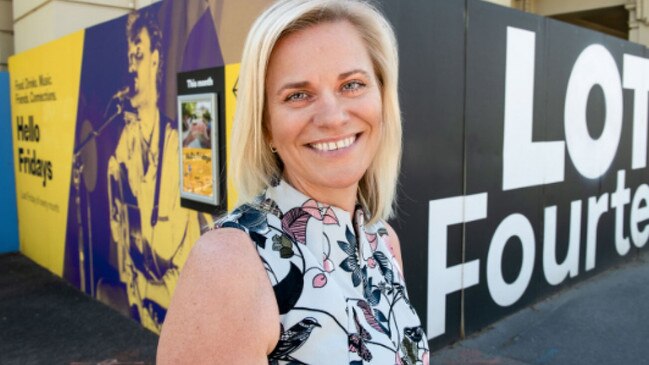
Dixon is referring to the likes of the space agency, machine learning institute and the close connections with the university, but also the links between tech giants, hi-tech companies, smaller businesses and start-ups.
In a word, an “ecosystem” has been created from scratch (spend any time at Lot Fourteen and you’ll hear that word a lot).
“We’ve managed to attract global players like Microsoft, Amazon and Google. Companies like that are actually attracted by having such a thriving start-up culture because they know the innovation, the new ideas, the new ways of thinking are evident within the process,” she says.
“So they’re able to gain benefits for that and then vice versa, those start-ups can gain benefits from having the opportunities of being in a really strong collaborative environment and ecosystem with those larger global players.”
One example of this “ecosystem” at work is the Kanyini Satellite, the state’s first, which will be used to monitor water levels for farmers to help determine future crop yields, and support emergency services personnel to monitor and manage large-scale disasters, such as bushfires.
The satellite is being built on-site by up and comer Inovor Technologies in partnership with internet of things and data specialists Myriota, alongside SmartSat CRC and the state government via the SA Space Industry Centre, which is a consortium of industry, government and research organisations.
“These sorts of things just wouldn’t be happening if people weren’t actually physically co located together,” Dixon says.
“And that’s the real value of physical districts, especially in this time when probably people are questioning whether people actually need physical locations, but that’s really where that sort of dynamic has happened.”
The to-do list from here is extensive and expensive.
There’s work going on with the Adelaide City Council and the Adelaide Economic Development Agency to support the start-ups who have “scaled up” and outgrown the precinct to find office space in the east end. Then there’s the creation of what will arguably be the centrepiece of the site, the Entrepreneur and Innovation Centre and Innovation Hub with $400m coming from private investment (Quintessential Equity), with construction expected to start early next year and take two years to build.
“They wouldn’t be doing that unless they could see that it’s going to be self-sustaining and grow,” Dixon says.
“Going forward we’ll start to see a lot more of that private investment coming in.”
That means more money and more jobs … if it all goes to plan.
THE HUB WHERE IT HAPPENS
It’s a month or so since the last visit and Stone & Chalk is a little quieter this time around. A few people mill around the coffee machine, a couple sit around a laptop behind a wall with the words “Scale Up, Start Up, Wake Up, Leave Up …” painted behind.
Conversations range from “capital” and “scale”, to that night’s whiskey tasting. The atmosphere is relaxed and familiar.
It’s a wet and cold Friday afternoon and Stone & Chalk’s general manager Chris Kirk looks like most of us do after a long week. It’s nothing, he says with a laugh, compared to the whirlwind of the past three years (or his decision to cycle across the US, from the Pacific to the Atlantic, for six months in 2016).
He moved here from Sydney to set up the Adelaide arm of Stone & Chalk, established the business, met his partner, built the business through a pandemic and now proudly calls Adelaide home.

Stone & Chalk set up shop in 2019 with a mission to support start-ups (businesses starting out) and scale-ups (start-ups that grow) with programs, mentoring and access to capital and customers, among other things.
They’re also about building a culture – and that word again: “ecosystem”.
Kirk is bullish about the future, having seen first-hand this entrepreneurial culture grow from nothing, or at least something that was largely hidden, to a bustling “centre of gravity” at Lot Fourteen.
“When we opened in South Australia, I remember having a whole bunch of info nights and all the rest of it; I was surprised at just the kind of newness of that concept,” he says.
Now he can point to figures which show that businesses started at the hub will employ more than 600 people by the end of the year across 55 companies; more than $90m in capital has been raised during that time and more than 15,000 people have taken part in events.
“We’re trying to increase the velocity of an entrepreneur’s path,” he says by way of explanation.
“So we’re trying to take companies from idea, to start up, through to scale up and really moving through that model as efficiently as possible.
“We’ve had teams now do kind of four times their headcount in the first year.
“They’ll start with three or four people, they’ll graduate with 20 to 25.”
It’s often high risk, so some work, some don’t, but that’s the nature of the game.
“Ultimately, what we are trying to do is be the start of that funnel for the future industry employees in South Australia,” he says.
Kirk is acutely aware of the challenges ahead. Not enough women founders, more support needed at schools, a lack of cut-through in the regions.
But he says it’s early days, the foundations are solid and work is being done across schools and the community to broaden the appeal from start-ups and scale-ups, to simply kids interested in technology.
“Number one’s talent and we’ve got lots of it,” he says.
“We’ve got one of the largest concentrations of AI, ML (machine learning) researchers just next door, we’ve got incredible strength of the university sector.
“We’ve got a lower cost of living, we’ve got a lot of economic advantages.
“And also we’ve got the potential to really, I think, capture the imagination of young people.”
The next stage to “change a culture and a DNA” is to develop SA role models, “signs of success”, to which kids can aspire.
He talks about using the example of companies going through start-ups and scale-ups and then exiting their business, with capital returns for local investors.
“It’s fantastic but also proves that entrepreneurship is a real thing. It creates money. These are real businesses, it’s not vapourware,” he says.
Particularly encouraging is some of those companies now wanting to give back, to mentor the next generation.
“A few years ago you’d come here and say, who are the people I’m going to point to and say ‘That’s what success looks like?’,” he says.
“Now we’ve got companies that have gone through that maturity cycle and we have a pool of mentors from those companies who have gone through the journey and been successful and now want to give back.
“And that was really hard to do a couple of years ago in South Australia.”
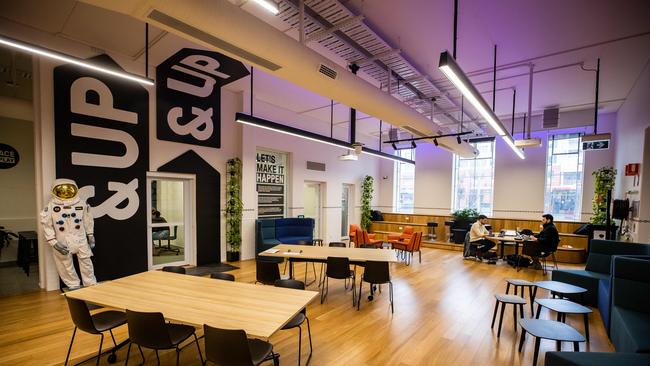
In a few years or so one of those might well be Adam Grocke.
A big guy in a puffer jacket who looks like he’s just spent the morning on the bench press, he’s also the founder of Sherlok, an AI-driven, high end intelligence platform for mortgage brokers (and a veteran of 188 SANFL games – including 166 at Woodville West Torrens).
His business monitors a client’s home loan rates, automatically reprices the rate with their current lender, detects refinancing opportunities, and delivers those leads via email.
“So the problem we’re solving is more than 80 per cent of homeowners have higher interest rates than what they need,” he says.
“It’s this loyalty tax that people talk about. And that costs over $15bn worth of extra interest per year across Australia.
“So we’ve built a platform that with a single click can reduce their existing rate, and we’re working on a single click refinancing to a new lender, if they’ve used a broker before.”
The product is in market, strategic partnerships have been signed with aggregators, work is underway with lenders. They’ve just clicked over 100,000 homeowners using the product and want to pump that up to more than a million across the next 6-12 months.
“Our mission is really to fundamentally change the whole industry,” he says matter-
of-factly.
Grocke happened across the idea during his 12 years working as a mortgage broker where he struggled to keep clients because the rates were too high. “And there was no way to help manage those clients and keep that rate competitive,” he says.
But if he could reduce the rate and keep it competitive for the life of the loan, they would stay. Sherlok was born.
Its growth has come largely via word of mouth, growing from a staff of three in January last year to 16.
He’s planning to put on more developers by Christmas.
He’s also acutely aware the product has also hit a sweet spot, with costs of living skyrocketing and more people looking to tighten their belts.
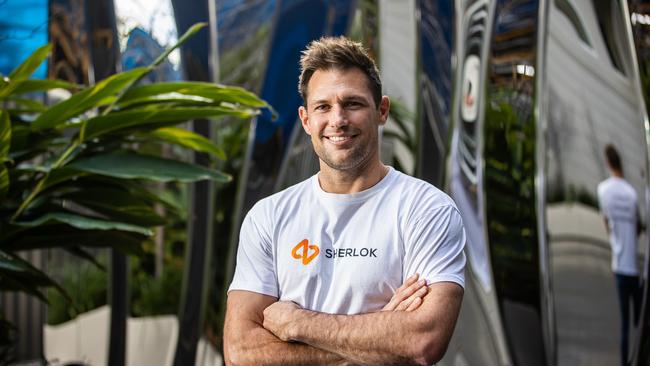
There’s Daish Malani (the guy wearing the VR goggles when we first visited) again, showing off a new sign for his business Add-Life Technologies, which is building VR technology to help people recover from brain injury.
Summer Petrosius is milling around. The founder of Kindship, she has just secured $350,000 state government seed funding for her app, the first in Australia designed for parents of children with a disability. It’s her birthday and there is a cake somewhere.
Mary Kelly is there. The founder of Reusably, for the past three and a half years she’s been working on a tech system that helps facilitate a swap system of reusable containers. “I was in the car one day and I heard on the radio that they wanted to ban single use plastic, reusable coffee cups in cafes, and I thought, ‘This is such a step backwards for sustainability’,” she says.
So under Kelly’s system, you would walk into a cafe, scan an electronic NFC tag, and order your hot drink.
“They’d serve it to you in a reusable cup or bowl. You’d then walk away, drink it and then you can return it to any participating outlet,” she says. They’re trialling the product on Kangaroo Island.
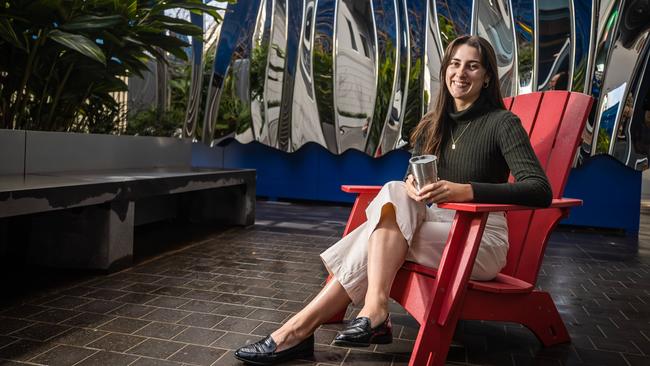
Denham D’Silva, founder of Barossa Valley Brewing is there, talking about his beer produced via artificial intelligence; he’s also working on a technology enabling brewers to cater beer recipes to customers’ individual tastes.
Ed* it turns out is Edward Robinson, a 19 year old from Gawler, who has put his uni studies on hold to throw himself in his project full-time – a plan to get schoolkids excited and inspired about space and the space industry.
He shows a CubeSat (a 10cm cube shaped satellite) he has built at home and becomes more animated as he talks.
This is clearly a passion for him. He tells the story of in Year 11 building a guided, carbon fibre model rocket with a 3D printed nose cone and landing legs, with an internal motor that somehow “moved” via a computer receiving measures from sensors and while crunching a bunch of mathematical algorithms. “It’d then go ‘Okay, where does this motor need to be to keep this rocket stable, or steer it on a particular trajectory?” he says.
Back to the CubeSat. It is what it says on the box: a well-made, silver cube. But this one won’t go into space.
“It’s a purely educational tool,” he says.
“Schools will receive it like a flat pack. It has all the aluminium pieces. All the electronics that go inside, all the solar panels that go around the outside, all the wiring screws, all that stuff, with really clear instructions on how the students can assemble their satellites.
“They can make it work so they get wireless signals to their computer and stuff like that.
“And yeah, I suppose the goal is to have at least one of these kits in every secondary school.”
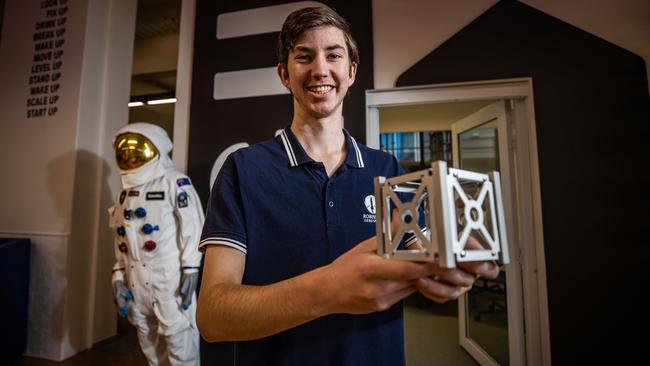
You sense you could throw a dart in here and find a story worth telling.
They all seem to know each other and have the easy familiarity of people comfortable in each other’s orbits. They all agree that the sense of community and the collegiate culture is among Stone & Chalk’s most endearing qualities.
Then there’s the mentoring, analysis, support systems and networks they all tap into each day to develop a genuine business out of something which, for most of them, began as little more than a seed of an idea.
“I slightly underestimated how hard it can be to start a company. Not slightly, radically,” Malani says with a broad grin.
“I didn’t even know what I was doing, I was just trying to make something worthwhile out of the technology that was available.
“I knew everything about the technology that I work with now, but I didn’t know anything about business.
“I got to know people that know how accounting works, or the legal system, or what support will be needed. I’ve felt surrounded by people that could always help me and assist people understanding the journey because whether you’re a one person company or a 20 person company, people are really talking and helping people in this environment.
“People would just go, ‘Oh, this person’s trying to do something really interesting, let’s try and get them support.
“So yeah, it’s been really amazing for me.”
Robinson describes it as simply as “the place to be”. He’s gone from knowing no one in the space industry, to being supported by a team of people, and being able to walk literally 20m across the courtyard to the space agency.
“So I’ve had a lot of meetings with a lot of different people and they’re always very interested in the idea because they also kind of see the need for space education and inspiring the students in the space industry,” he says.
“And that, yeah, they provide a lot of good feedback and also ask some really tough questions.”
Almost on cue, someone from Chief Entrepreneur Andrew Nunn’s office takes him aside to discuss something about more people wanting to talk to him about his project. It’s not clear what it’s about and it seems a little impolite, this late in the day, to pry.
There’s that “ecosystem” word again.
They are adamant it is not staged.
THE CHIEF ENTREPRENEUR
Andrew Nunn recalls sitting in a hotel room in Adelaide in the late 1990s, crying his eyes out, thinking this was the worst decision he had ever made. He was working as an environmental engineer and agreed to take a one-year contract in the City of Churches.
So looking back, what would you say to your 20-something self, 20-odd years later?
“Smart move, be brave,” he says without hesitating over a coffee at Lot Fourteen’s bustling Community cafe.
“What often seem to be the biggest risks are the ones that pay off the most.”
Since then Nunn launched his own business remediating contaminated sites (it went national), raised a family, invested in more local businesses than he can reel off the top of his head, started a philanthropic foundation, bought, sold, merged, reinvested – wash, rinse, repeat – and is now South Australia’s Chief Entrepreneur.
Much like the 20-something with the fragile tears to the captain of industry he has since become, he has seen the state change from a mendicant basket case hamstrung by the collapse of its state bank, to one that is, at the very least, he sees as starting to believe in itself.
He’s no Pollyanna, he knows the challenges with migration, the continuing brain drain to the eastern states, the over-reliance on GST revenues and handouts, the inferiority complex, the chip on the shoulder, the growing international economic headwinds …
He also believes there is change in the air.
And if the start-up culture and innovation and attraction of international businesses he sees coming out of Lot Fourteen aren’t the most significant changes he’s seen in his time here, it’s in the top few.
“Putting seven hectares of innovation right here in the CBD is a lightning rod for where you should focus your efforts. This should now be a global lightning rod for innovation,” he says.
It has also helped the state’s self-esteem, he says.
“There’s a belief here now,” Nunn says. “The construction of Tonsley and then of the Lot Fourteen innovation district in the city were both really good ideas because they both put a spotlight on innovation and that has only happened because we have bipartisan views in this state on South Australia’s innovation capability and potential.”

The key is now to build on those foundations and embed a genuine entrepreneurial spirit and culture in the city and state, he says while referencing Adelaide’s sister city, Austin, as a prime example. “Austin’s motto is ‘Keep Austin Weird’,” he says. “That’s the Austin way. Austin’s rebuilt itself. They’re happy with who they are. They don’t need to be Silicon Valley, they don’t need to be New York, they’re happy. We need to be comfortable in our own skin. To say, ‘This is us, we’re good here’.”
And he says the city should now strive to be known for its innovation. For leading, not following.
One day he would love to see cars with licence plates celebrating “South Australia – The Innovation State”, capitalising on a culture of entrepreneurship but also celebrating a market that’s big enough to test and refine concepts, but not so big that any failure is fatal.
“I don’t think any state puts their hand up and says, ‘We’re the entrepreneurial state’, they have it off to the side and they do their other stuff,” he says.
“We’ve put this (Lot Fourteen) in the middle of the city, we need to be the entrepreneurial state, we need to be the sandbox state.
“We need to be like Silicon Valley – Come and have a try here.”
There is still a ways to go though, he says.
He echoes Kirk’s concerns on a lack of female founders. He also wants to see more schools embracing the concept (SA has five special entrepreneurial schools – Heathfield High, Seaton High, Banksia Park International, Mt Gambier, Murray Bridge), as well as continual political, business and community leadership.
“First and foremost we’ve got to get the kids,” he says. “We need a lot more female founders and so to do that, we need to talk to the schoolkids.
“There’s five entrepreneurial high schools and you get the kids to present to you what they’ve done, what they’re thinking.
“And you look at the Year 12s telling you how proud they are. And a lot of these kids think outside the square. They’re not the rote learning kids. These are the kids who are probably seen as the mischievous ones, or the loud ones, or the ones who can’t concentrate in class because their brains are always moving.
“You walk out of there with a tear in your eye and you realise we’re actually in a good place.”
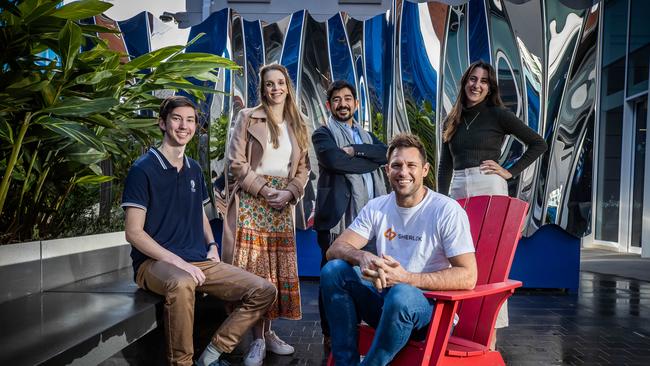
The key now is to expand on these types of programs and spend the next decade or so developing the culture, role models and success stories, Nunn says.
“I’m a big believer in saying you can’t be what you can’t see, particularly for kids at that age, years 7-12. “They need to see that leadership, they need to see examples of who they aspire to be. And then they think they can do it.”
Nunn argues this is not only fundamental for building a genuine culture but a centrepiece of strategy if the state ever hopes to stand on its own two feet away from government handouts and the vagaries of GST dividends.
“I sit on a number of private, commercial boards and I hate it when it’s asked ‘How do we get more money out of government?’ whether it’s state or federal,” he says.
“How about we look at how we stand up and then we can choose our own destiny? Let’s do that.
“There’s always a role for government to add value to what we do, but the more that we can actually control our own destiny, the better.”
Lot Fourteen is one almighty step in the right direction, he says, and that word “ecosystem” makes its final appearance.
“This thing is like a focal point, it’s almost co-ordinated dating,” he says.
“You know, you guys need to meet these guys, and you need to work together. By creating an environment where people can actually sit and have a chat about what they do in the same spot … it just helps. When you do everything by Zoom, there’s no culture.”
He smiles when it’s put to him one of the criticisms of the precinct is that it’s all smoke and mirrors with little substance.
“I’ll walk you around and introduce you to 50 start-ups that will blow your mind,” he says.
We assure him that work has already been done.



